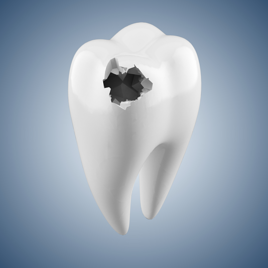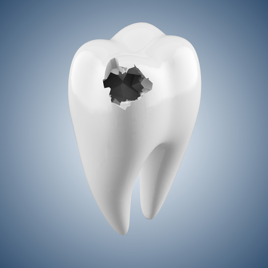Tooth Decay - How It All Happens


 The mouth contains bacteria that require food in order to survive and multiply. Eating foods that contain sugar and carbohydrates can prompt the bacteria to produce acids that attack the tooth enamel, which is the tooth's outermost layer.
The mouth contains bacteria that require food in order to survive and multiply. Eating foods that contain sugar and carbohydrates can prompt the bacteria to produce acids that attack the tooth enamel, which is the tooth's outermost layer.
Not only sugary foods like ice cream and candy, but even those containing carbohydrates ultimately break down to form easily digestible sugars. Sugars like glucose and fructose are formed due to this breaking up. The entire process starts in the mouth itself for certain types of food known as fermentable carbohydrates. Some obvious examples of fermentable carbohydrates are foods like candy, soft drinks, cakes and cookies. Less obvious ones are potato chips, crackers, pretzels, bananas and breakfast cereals.
Bacteria that are present in the mouth initiate the chemical changes in these foods, and, as a result, acids are formed. The acids then start attacking the dental mineral crystals which start dissolving. After each time you eat these foods, the teeth get exposed to fresh waves of attack. These attacks result in tooth decay, otherwise known as dental caries. The first telltale sign of this decay appears as a white spot on the affected area. The weakened tooth may still appear smooth as it starts losing minerals beneath the surface.
Some steps may be taken to prevent further damage. Start by brushing more frequently using fluoride toothpaste - ideally after each meal and eating foods that contain proteins. Chewing gum (sugar free of course!), will facilitate saliva flow. Increased saliva flow is protective against tooth decay as saliva contains calcium and phosphate that helps to reduce the acidity in the mouth which is caused by the bacterial action.
Once the tooth enamel is eroded enough to cause a cavity, there is no way to undo the damage. It is necessary to visit a dental professional to get the decay removed and get the cavity filled. If the cavity is neglected, the tooth will suffer even more damage. The erosion works its way past the enamel and destroys the inner layer of dentin and ultimately attacks the tooth pulp, which contains nerves and blood vessels.
Please remember that any tooth loss is permanent in adults. Losing a tooth due to neglect is in not excusable as it imposes debilitating effects on lifestyle and self-esteem. Moreover, an extracted tooth creates empty space that fails to give support to the adjoining teeth and jaw bone. The neighboring teeth, as a result, tend to cave in under pressure from chewing or involuntary mouth movements during sleep. These teeth lose firmness and can suffer mechanical damage. So, the best way to treat tooth decay is at an early stage, that’s why preventive visits to the dentist take place once every six months.



